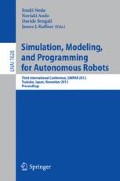Abstract
Fidelity with friction properties and easiness of implementation are both important aspects for friction modeling. Some empirically motivated models can be implemented easily due to their simple expression and small number of parameters, but they cannot capture faithfully the main properties of friction. Some physically motivated models give close agreement with the friction properties, but they can be too complex for some applications. This paper proposes a differential-algebraic multistate friction model that possesses easiness of implementation and adjustment, a relatively small number of parameters and a compact formulation. Moreover, it captures all standard properties of well-established friction models.
Access this chapter
Tax calculation will be finalised at checkout
Purchases are for personal use only
Preview
Unable to display preview. Download preview PDF.
References
Al-Bender, F., Lampaert, V., Swevers, J.: The generalized maxwell-slip model: a novel model for friction simulation and compensation. IEEE Trans. on Automatic Control 50(11), 1883–1887 (2005)
Dahl, P.: A solid friction model. Tech. rep., Aerospace Corporation, El Segundo, CA (1968)
Canudas de Wit, C., Olsson, H., Åström, K.J., Lischinsky, P.: A new model for control of sytem with friction. IEEE Trans. on Automatic Control 40(3), 419–425 (1995)
Åström, K.J., Canudas-de-Wit, C.: Revisting the LuGre friction model. IEEE Control Systems Magazine 28(6), 101–114 (2008)
Dupont, P., Hayward, V., Armstrong, B., Altpeter, F.: Single state elastoplastic friction models. IEEE Trans. on Automatic Control 47(5), 787–792 (2002)
Swevers, J., Al-Bender, F., Ganseman, C.G., Prajogo, T.: An integrated friction model structure with improved presliding behavior for accurate friction compensation. IEEE Trans. on Automatic Control 45(4), 675–686 (2000)
Al-Bender, F., Lampaert, V., Swevers, J.: A novel generic model at asperity level for dry friction force dynamics. Tribology Letters 16(1-2), 81–93 (2004)
Moerlooze, K.D., Al-Bender, F., Brussel, H.V.: A generalized asperity-based friction model. Tribology Letters 40(1), 113–130 (2010)
Al-Bender, F., Swevers, J.: Characterization of friction force dynamics. IEEE Control Systems Magazine 28(6), 64–81 (2008)
Lampaert, V., Al-Bender, F., Swevers, J.: Experimental characterization of dry friction at low velocities on a developed tribometer setup for macrosopic measurements. Tribology Letters 16(1-2), 95–105 (2004)
Lampaert, V., Swevers, J., Al-Bender, F.: Modification of the leuven integrated friction model structure. IEEE Trans. on Automatic Control 47(4), 683–687 (2002)
Lampaert, V., Al-Bender, F., Swevers, J.: A generalized maxwell-slip friction model appropriate for control purposes. In: Proc. of IEEE International Conference on Physics and Control, St. Petersburg, Russia, pp. 1170–1177 (2003)
Iwan, W.D.: A distributed-element model for hysteresis and its steady-state dynamic response. Trans. ASME: J. of Applied Mechanics 33(4), 893–900 (1966)
Goldfarb, M., Celanovic, N.: A lumped parameter electromechnical model for describing the nonlinear behavior of piezoelectric actuators. Trans. ASME: J. of Dynamic Systems, Measurement, and Control 119, 478–485 (1997)
Lazan, B.J.: Damping of Materials and Members in Structural Mechanics. Pergamon Press, London (1968)
Xiong, X., Kikuuwe, R., Yamamoto, M.: A differential-algebraic method to approximate nonsmooth mechanical systems by ordinary differential equations. Submitted to Multibody System Dynamics
Kikuuwe, R., Yasukouchi, S., Fujimoto, H., Yamamoto, M.: Proxy-based sliding mode control: a safer extension of PID position control. IEEE Trans. on Robotics 26(4), 670–683 (2010)
Leine, R.I., Nijmeijer, H.: Dynamics and Bifurcations of Non-smooth Mechanical Systems. LNACM, vol. 18. Springer, Berlin (2004)
Brogliato, B., Daniilidis, A., Lemarechal, C., Acary, V.: On the equivalence between complementarity systems, projected systems and differential inclusions. Systems & Control Letters 55(1), 45–51 (2006)
Kikuuwe, R., Takesue, N., Sano, A., Mochiyama, H., Fujimoto, H.: Admittance and impedance representations of friction based on implicit Euler integration. IEEE Trans. on Robotics 22(6), 1176–1188 (2006)
Gonthier, Y., Mcphee, J., Lange, C., Piedbœuf, J.C.: A regularized contact model with asymmetric damping and dwell-time dependent friction. Multibody System Dynamics 11(3), 209–233 (2004)
Author information
Authors and Affiliations
Editor information
Editors and Affiliations
Rights and permissions
Copyright information
© 2012 Springer-Verlag Berlin Heidelberg
About this paper
Cite this paper
Xiong, X., Kikuuwe, R., Yamamoto, M. (2012). A Differential-Algebraic Multistate Friction Model. In: Noda, I., Ando, N., Brugali, D., Kuffner, J.J. (eds) Simulation, Modeling, and Programming for Autonomous Robots. SIMPAR 2012. Lecture Notes in Computer Science(), vol 7628. Springer, Berlin, Heidelberg. https://doi.org/10.1007/978-3-642-34327-8_10
Download citation
DOI: https://doi.org/10.1007/978-3-642-34327-8_10
Publisher Name: Springer, Berlin, Heidelberg
Print ISBN: 978-3-642-34326-1
Online ISBN: 978-3-642-34327-8
eBook Packages: Computer ScienceComputer Science (R0)

